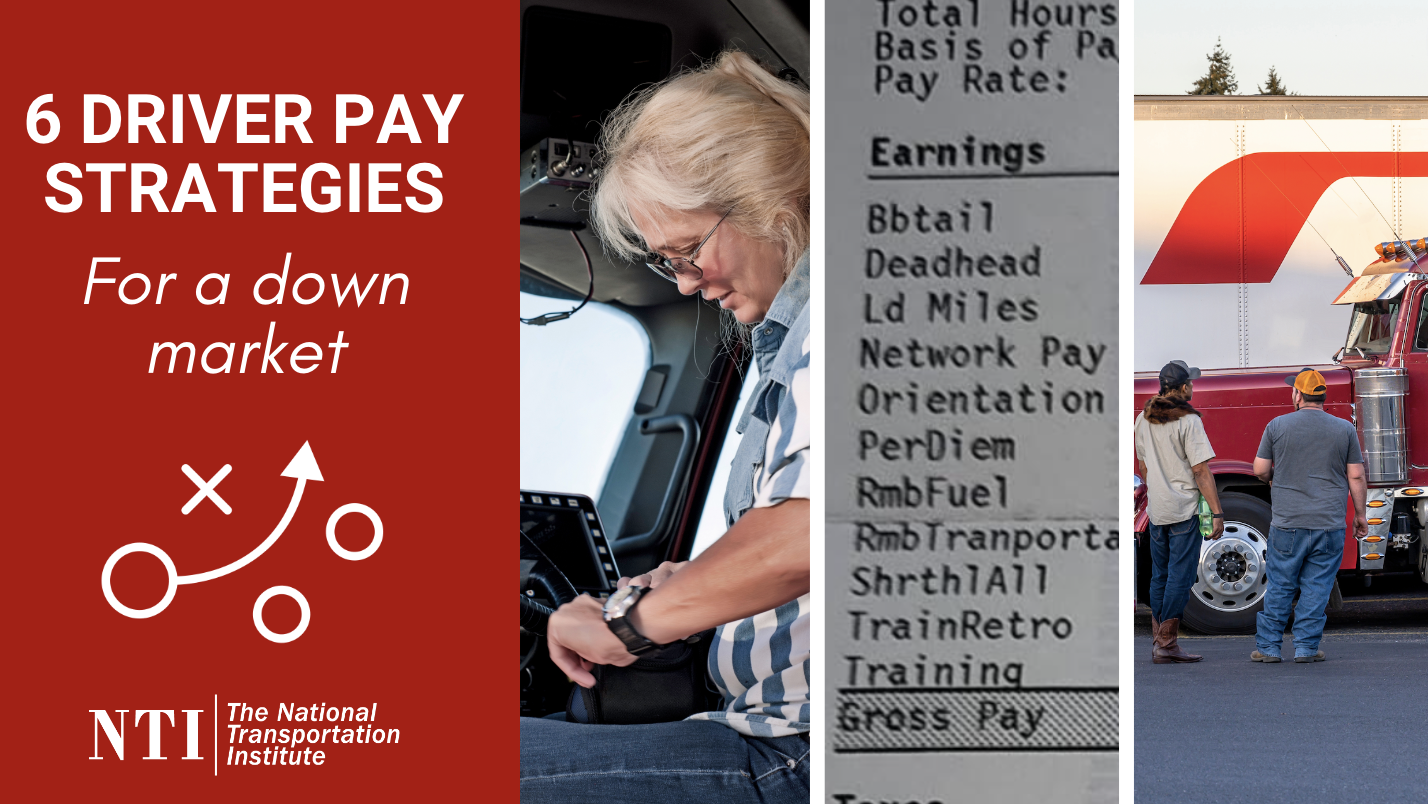




One predominant theme remains, even as hiring pressures ease: The macro, secular shifts in the labor market and workers’ relationships with their employers will persist through the current downcycle. These are long-term trends fleets must contend with.
With the right mix of compensation incentives and with active conversations to engage internal stakeholders and drivers, fleets can continue to recruit and retain effectively while also boosting productivity and managing expenses.
Here are six strategies your fleet to consider in this slower freight market:

Fleets of all types should still be looking across the board at pay trends, even if base pay (mileage and hourly) isn’t THE trending topic. NTI survey data still shows elevated activity for benchmarking of incentives, bonuses, location-based hiring, and guaranteed pay programs.
Recruiting, HR, and compensation teams aren’t the only departments that analyze compensation trends. When sales and operations are working on pricing new business or re-bidding existing contracts, benchmarking current market labor costs is critical to bid contracts competitively and profitably, and to know your fleet can hire the capacity needed to service those contracts quickly effectively.

Hold conversations internally with leadership, operations, recruiting, HR, and other relevant departments to find your pay specialty.
Drivers who’ve been at your fleet for less than three years, which may be a large swath of your driver pool, may have never dealt with layover pay. So ensure that your driver managers and other points of contact for drivers understand your total compensation play and can communicate it effectively to drivers. We recently explored this topic in-depth in the NTI Blog. Read more about navigating layover pay and a few trends from NTI survey data.

If you don’t have an mpg program to reward drivers, implement one. Then, market to your drivers the opportunity to pad their paychecks with better fuel economy. Also, take stock of your in-network fuel compliance rates and find opportunities to reward drivers for fueling in-network, which could add up to big savings for your fleet.
Crashes are costly financially and emotionally. Likewise, insurance costs have become a key concern for carriers of all sizes. Find opportunities to financially incentivize safe driving habits. Likewise, productivity incentives and bonuses can help your fleet run leaner and more effectively while also being a compensation boon for drivers.
Ensure your drivers are aware of the referral bonus you provide. This creates a mobile team of ambassadors for your company who can not only help fill your recruiting pipeline, but also who feel more invested in and engaged with your company.

Keep them engaged and productive by training them with new skills and plugging them into other areas of need at your company.
Recruiting is inherently a sales role. Thus, your recruiters already have the skillset needed to cold call customer prospects and perform sales functions. Have them work with your sales and business development departments to call shippers and brokers and try to find new business for your fleet when they’re not busy performing their recruiting functions.
If they’re not busy recruiting, push them to become retention ambassadors. Have them regularly call and check in with drivers to address any issues and to consistently re-sell your company. Recruiting doesn’t stop once a driver is seated.
Your recruiting team, especially in recent years, likely focuses primarily on new applications. However, thousands of drivers have applied to your fleet in recent years. So, remind recruiters to work their pipeline by re-calling leads and applicants who may be a good fit for your fleet but weren’t hired at the time of their application. Or drivers who may not have met your experience requirements, but now do. These skills will be invaluable when hiring pressures return.

Guaranteed weekly pay gives drivers peace of mind and removes one of their biggest frustrations: Inconsistent and lumpy paychecks week to week. It maintains the company’s position as a sought-after employer. However, you don’t want to put your company in a weaker financial position by providing guaranteed pay.
Guaranteed pay becomes a fixed cost for your business, rather than allowing pay to be a variable cost tied to drivers’ productivity. So make sure guaranteed pay doesn’t become a financial burden that your company can’t meet.
This could be a positive or a negative. But from lack of driver productivity to underlying operational issues, guaranteed pay can shine a light on some of your fleet’s bad habits.
Find ways to supplement it to still give drivers peace of mind and better consistency in their paychecks.

Are applications stacking up on terminal managers’ desks after they’re vetted and approved by recruiting? Can you find areas to improve your time to hire? Are there holes in your onboarding process? As we’ve said, now’s the time to invest in your business, take stock of what’s working and what’s not and to vet your programs and processes to ensure they’re effective before the next pressure cycle circles back around.
Now’s the time to take an aggressive and active approach to hearing feedback from your people and responding appropriately. The market will cycle back, and when it does, your fleet won’t have the opportunity it does in the current environment to react and make policy changes that support your hiring and retention goals.
If your fleet needs industry-leading data or expert guidance to help steer your professional driver and technician compensation planning, contact our team of experts today.
Fill out the form below to receive our driver-focused communications and to receive information about best-in-class professional driving jobs.

On the first Thursday of every month, NTI President & CEO Leah Shaver, aka the Sunshine Girl, goes live on air on SiriusXM Channel 146, Road Dog Trucking, to talk with drivers about all things pay. From paycheck questions to working with fleets on resolving issues around compensation, HR and legal, life on the road, and relationships with their employers, Payday on Road Dog Live dives into topics drivers care about most.
Catch every episode live on SiriusXM, SiriusXM.com, or the SiriusXM app, where you can also listen to episodes on demand.